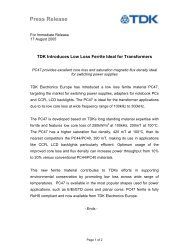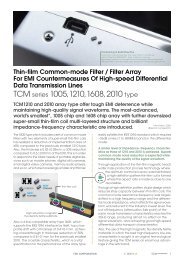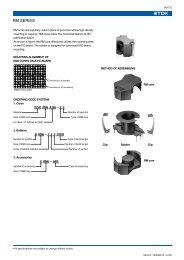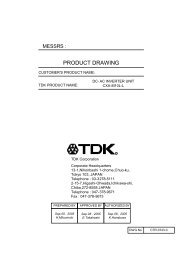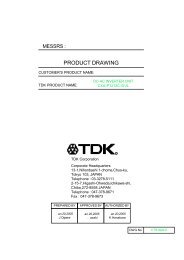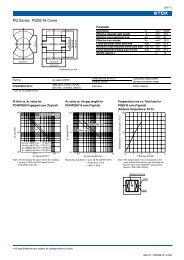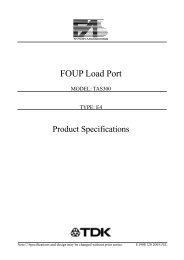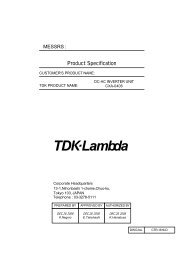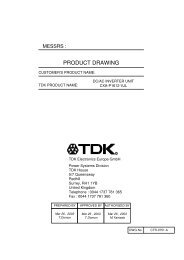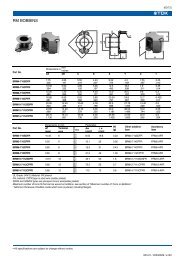LOW LOSS FERRITE MATERIAL FOR POWER SUPPLY PC47
LOW LOSS FERRITE MATERIAL FOR POWER SUPPLY PC47
LOW LOSS FERRITE MATERIAL FOR POWER SUPPLY PC47
- No tags were found...
You also want an ePaper? Increase the reach of your titles
YUMPU automatically turns print PDFs into web optimized ePapers that Google loves.
(18/73)<strong>LOW</strong> <strong>LOSS</strong> <strong>FERRITE</strong> <strong>MATERIAL</strong> <strong>FOR</strong> <strong>POWER</strong> <strong>SUPPLY</strong> <strong>PC47</strong><strong>PC47</strong> has the best properties for transformers of power supplies, adapters and chargers.The core loss and saturation magnetic flux density of <strong>PC47</strong> are far better than PC44 and PC40 which are currently in use.FEATURES• Core loss: 250kW/m 3 at 100kHz, 200mT, 100°C.• Low core loss at wide frequency range 100kHz to 300kHz.• Higher saturation flux density than PC44.APPLICATIONS• Switching power supplies• Adapters and chargers for notebook type pc• CCFL LCD backlight<strong>MATERIAL</strong> CHARACTERISTICSMaterial <strong>PC47</strong> PC44 PC40Initial permeability µi 25°C 2500±25% 2400±25% 2300±25%Core loss volume density[100kHz, 200mT]Saturation magnetic flux density[1000A/m]Remanent flux density Br mTPcv TEMPERATURE DEPENDENCE CHARACTERISTICS (Typical)Pcv kW/m 3 60°C 400 400 45025°C 600 600 600100°C 250 300 410Bs mT25°C 530 510 510100°C 420 390 39025°C 180 110 95100°C 60 60 55Curie temperature Tc °C min. 230 215 215Density db kg/m 3 4.9×10 3 4.8×10 3 4.8×10 3Core loss Pcv(kW/m 3 )1000900800700600500400300200100100kHz/200mTPC40PC44<strong>PC47</strong>0 0 20 40 60 80 100 120 140Temperature(˚C)Core loss Pcv(kW/m 3 )60005500500045004000350030002500200015001000500200kHz/300mTPC40PC44<strong>PC47</strong>00 20 40 60 80 100 120 140Temperature(˚C)Bs and Br TEMPERATURE DEPENDENCE CHARACTERISTICS (Typical)600500BsBs, Br(mT)400300200100<strong>PC47</strong>PC44PC40<strong>PC47</strong>PC44PC40Br00 20 40 60 80 100 120 140 160Temperature(˚C)• All specifications are subject to change without notice.003-01 / 20040913 / e130.fm
(19/73)µi vs. FREQUENCY CHARACTERISTICS (Typical) µi vs. TEMPERATURE CHARACTERISTICS (Typical)10000800070006000µi1000PC40PC44<strong>PC47</strong>µ i500040003000PC40PC44<strong>PC47</strong>2000100010010 100 1000 10000Frequency(kHz)0–80 –40 0 40 80 120 160 200 240 280 320 360Temperature(˚C)MAGNETIZATION CURVES (Typical)<strong>MATERIAL</strong>:<strong>PC47</strong>µa TEMPERATURE DEPENDENCE CHARACTERISTICS(Typical)Flux density B(mT)55050045040035030025020015010050025˚C60˚C80˚C100˚C120˚C0 200 400 600 800 1000 1200Magnetic field H(A/m)µ a10000900080007000600050004000300020001000200kHz/300mT<strong>PC47</strong>PC44PC4000 20 40 60 80 100 120 140Temperature(˚C)• All specifications are subject to change without notice.003-01 / 20040913 / e130.fm
(20/73)<strong>LOW</strong> <strong>LOSS</strong> <strong>FERRITE</strong> <strong>MATERIAL</strong>S <strong>FOR</strong> <strong>POWER</strong> <strong>SUPPLY</strong> PC45 AND PC46In recent years, with the advent of notebook type pc, VCR’s, digital camera’s and mobile communication devices, technological demandshave risen for higher performance CCFL LCD backlight units that have smaller sizes, lower profiles and higher efficiency.The PC45 and PC46 are materials developed to achieve higher efficiency in designing minimize core loss at practical temperature ranges(PC45: 60 to 80°C and PC46: 40 to 50°C) and high saturation flux density.They are also suitable for the transformers of DC to DC converters and adapters of notebook type pc.APPLICATIONS• Switching power supplies• Adapters and chargers for notebook type pc• CCFL LCD backlight<strong>MATERIAL</strong> CHARACTERISTICSMaterial PC45 PC46 PC44Initial permeability µi 25°C 2500±25% 3200±25% 2400±25%Core loss volume density[100kHz, 200mT]Saturation magnetic flux density[1000A/m]Remanent flux density Br mTPcv kW/m 3 60°C 250(75°C) 250(45°C) 40025°C 570 350 600100°C 460 660 300Bs mT25°C 530 530 510100°C 420 410 39025°C 120 80 110100°C 80 115 60Curie temperature Tc °C min. 230 230 215Density db kg/m 3 4.8×10 3 4.8×10 3 4.8×10 3Pcv TEMPERATURE DEPENDENCE CHARACTERISTICS(Typical)Bs and Br TEMPERATURE DEPENDENCECHARACTERISTICS (Typical)Core loss Pcv(kW/m 3 )1000900800700600500400100kHz/200mTPC46PC45PC443002001000 0 20 40 60 80 100 120 140Temperature(˚C)Bs, Br(mT)6005004003002001000BsBrPC45PC46PC44PC46PC45PC440 20 40 60 80 100 120 140 160Temperature(˚C)µi vs. FREQUENCY CHARACTERISTICS (Typical) µi vs. TEMPERATURE CHARACTERISTICS (Typical)1000080007000µi1000PC44PC46PC45µ i600050004000PC44PC45PC4630002000100010010 100 1000 10000Frequency(kHz)0–80 –40 0 40 80 120 160 200 240 280 320 360Temperature(˚C)• All specifications are subject to change without notice.003-01 / 20040913 / e130.fm
(21/73)MAGNETIZATION CURVES<strong>MATERIAL</strong>:PC45<strong>MATERIAL</strong>:PC46Flux density B(mT)55050045040035030025020015025˚C60˚C80˚C100˚C120˚CFlux density B(mT)55050045040035030025020015025˚C60˚C80˚C100˚C120˚C100100505000 200 400 600 800 1000 1200Magnetic field H(A/m)00 200 400 600 800 1000 1200Magnetic field H(A/m)• All specifications are subject to change without notice.003-01 / 20040913 / e130.fm



